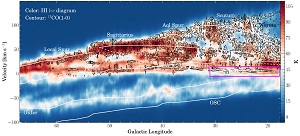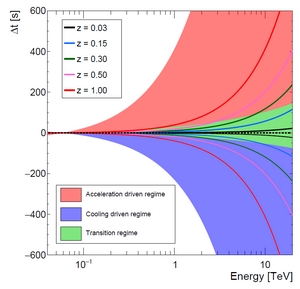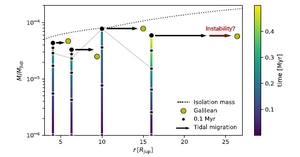Reionization optical depth determination from Planck HFI data with ten percent accuracy (Pagano et al.)
- Details
- Published on 16 March 2020
Vol. 635
3. Cosmology
Reionization optical depth determination from Planck HFI data with ten percent accuracy
While it is true that the reionization optical depth determination has been greatly improved over the last two decades, tau is still the less constrained parameter of the lambdaCDM model. Uncertainties and systematics produce discrepant results for different large-scale CMB datasets (primarily Planck and WMAPS) and various methods. In this paper, the authors present an advanced approach to the Planck High Frequency Instrument (HFI) data using an improved version of the HFI map-making code, greatly reducing the residual large-scale contamination affecting the data. With large-scale polarization-only data, they measured tau = 0.0566 +0.0053 -0.0062 at 68% C.L., reducing the Planck 2018 legacy release uncertainty by ~40%. Within the lambdaCDM model, applied in combination with the Planck large scale temperature likelihood and the high-temperature and polarization likelihood, they measured tau = 0.059ą0.006 at 68% C.L. which corresponds to a mid-point reionization redshift of z re = 8.14ą0.61. This estimation of the reionization optical depth with 10% accuracy is the strongest constraint obtained to date.Plasma-environment effects on K lines of astrophysical interest (Deprince et al.)
- Details
- Published on 09 March 2020
Vol. 635
12. Atomic, molecular, and nuclear data
Plasma-environment effects on K lines of astrophysical interest III. IPs, K thresholds, radiative rates, and Auger widths in Fe ix – Fe xvi
X-ray spectroscopy is the primary tool used to achieve an understanding of the inner zones of accretion flows in a wide variety of cosmic sources, particularly neutron stars and black holes. The resonance lines of highly ionized species of iron are among the most important spectral diagnostics available. This paper presents a novel, detailed study of the hitherto neglected ambient effects of plasma screeing and K transition wavelength shifts and thresholds, as well as the reduction in the ionizaton energies, on the interpretation of observations from the high-density environments expected in the inner portions of such flows.High-precision polarimetry of nearby stars (Piirola et al.)
- Details
- Published on 06 March 2020
Vol. 635
6. Interstellar and circumstellar matter
High-precision polarimetry of nearby stars (d<50 pc)
Understanding the magnetic field of the interstellar medium (ISM) in the vicinity of the Sun is a supremely challenging task, requiring ultra-high-precision polarimetric measurements of as large a sample of stars with known distances as possible. This benchmark study uses a sample of 361 bright F and G stars to obtain UBV photometric polarimetry to a remarkable level, 10^(-5). A subset of the sample of nonactive stars shows some marginal evidence of variability, which is probably intrinsic. A key result is the delineation of large angular-scale coherent filamentary structures, which are detected in the position angle maps that correspond to features known from the local ISM. In particular, there is a signature of the Interstellar Boundary EXplorer (IBEX) ribbon that is connected with the local IS magnetic field, which was modified by the heliosphere. The study also shows correlations between high-latitude large arc structures revealed by samples at distances from 100 to 500 pc and those closer than 50 pc.Hunting for open clusters in Gaia DR2: 582 new open clusters in the Galactic disc (Castro-Ginard et al.)
- Details
- Published on 04 March 2020
Vol. 635
5. Galactic structure, stellar clusters and population
Hunting for open clusters in Gaia DR2: 582 new open clusters in the Galactic disc
 Open clusters have served as vital laboratories for the development and testing of stellar evolution theory. These clusters have also been fundamental for the exploration of the disk in our own Milky Way. The Gaia mission has now enabled the discovery study of massive numbers of Galactic star clusters. As such, the present discovery of 582 new open clusters using machine learning techniques is a treasure. These objects are very tricky to detect due to the high level of contamination related to their being embedded in the Galactic disk. They have been found as clear overdensities in the spatial and proper-motion parameter space, which was confirmed using Gaia optical photometry. Interestingly, the new data also facilitated the discovery of the tidal tails from an intermediate-age open cluster that is in the process of being disrupted by the Galactic tidal field, illustrating the potential of combining Gaia data with these modern machine learning techniques. A great deal of progress is expected to be made on this front in the future as we all eagerly await Gaia DR3.
Open clusters have served as vital laboratories for the development and testing of stellar evolution theory. These clusters have also been fundamental for the exploration of the disk in our own Milky Way. The Gaia mission has now enabled the discovery study of massive numbers of Galactic star clusters. As such, the present discovery of 582 new open clusters using machine learning techniques is a treasure. These objects are very tricky to detect due to the high level of contamination related to their being embedded in the Galactic disk. They have been found as clear overdensities in the spatial and proper-motion parameter space, which was confirmed using Gaia optical photometry. Interestingly, the new data also facilitated the discovery of the tidal tails from an intermediate-age open cluster that is in the process of being disrupted by the Galactic tidal field, illustrating the potential of combining Gaia data with these modern machine learning techniques. A great deal of progress is expected to be made on this front in the future as we all eagerly await Gaia DR3.
Stripped stars during the reionization of hydrogen and helium (Götberg et al.)
- Details
- Published on 25 February 2020
Vol. 634
Sect. 3. Cosmology
Contribution from stars stripped in binaries to cosmic reionization of hydrogen and helium
The presence of massive binary stars has been known to boost the production of ionizing radiation in the stellar populations: as such, it is extremely important to assess their contribution in the global ionizing budget during the reionization transition. In this work, the authors investigate the contribution of stars stripped of their hydrogen-rich envelopes in binaries. Such envelope-stripping is predicted to be the most common type of interaction in binaries as it is the fate of a third of all massive stars. Because stars over a wide range of masses can become stripped, the resulting ionizing radiation is emitted over an extended period of time after a starburst, therefore, these systems can boost the ionizing emission of stellar populations at late times. The authors find that stars stripped in binaries are likely to have had important effects on cosmic reionization since they could have provided ∼ 20% of the photons that reionized hydrogen in the Universe. On the other hand, the He ii-ionizing emission from stripped stars is not sufficient to compete with AGN and significantly impact the complete reionization of helium, although they might have contributed to the initial part of this process. Finally, the harder resulting spectra from stellar populations lead to an increased temperature of the IGM during reionization, although current high-redshift temperature measurements using the Lyα forest are probably not sensitive enough to detect such differences.
THOR data release 2 (Y. Wang et al.)
- Details
- Published on 12 February 2020
Vol. 634
6. Interstellar and circumstellar matter
The HI/OH/recombination line survey of the inner Milky Way (THOR): data release 2 and H I overview
 The Data Release 2 of The HI/OH/recombination line survey of the Milky Way (THOR) provides the most detailed view so far of the first Galactic quadrant at a 21 cm wavelength. The authors have combined observations from the Karl G. Jansky Very Large Array (VLA) and Green Bank Telescope (GBT) to recover the large-scale structure of the HI emission and achieve an angular resolution of 40". Among their results, the authors derive an opacity-correction factor that implies a total atomic gas mass of 9.4–10.5x10^9 M_sun when applied to the entire Milky Way.
The Data Release 2 of The HI/OH/recombination line survey of the Milky Way (THOR) provides the most detailed view so far of the first Galactic quadrant at a 21 cm wavelength. The authors have combined observations from the Karl G. Jansky Very Large Array (VLA) and Green Bank Telescope (GBT) to recover the large-scale structure of the HI emission and achieve an angular resolution of 40". Among their results, the authors derive an opacity-correction factor that implies a total atomic gas mass of 9.4–10.5x10^9 M_sun when applied to the entire Milky Way.
Modeling spectral lags in active galactic nucleus flares in the context of Lorentz invariance violation searches (Perennes et al.)
- Details
- Published on 23 January 2020
Vol. 633
In section 4. Extragalactic astronomy
Modeling spectral lags in active galactic nucleus flares in the context of Lorentz invariance violation searches

The paper indicates that intrinsic time delays, produced by acceleration and radiation mechanisms during blazar flares, can compromise searches for Lorentz invariance (LIV) violations at TeV energies. The authors simulated time dependent one-zone models, including inverse Compton and synchrotron losses. They concentrate on two acceleration regimes, long persistent and fast particle acceleration, and note that such spectral observations with the Cherenkov Telescope Array (CTA) will provide the new insights needed for active galactic nuclei (AGN) flare modeling, which will improve our ability to disentangle such systematics from LIV searches in the photon sector.
Planet formation around M dwarfs via disc instability (Mercer & Stamatellos)
- Details
- Published on 21 January 2020
Vol. 633
Sect. 10. Planets and planetary systems
Planet formation around M dwarfs via disc instability. Fragmentation conditions and protoplanet properties

Around 30 percent of the observed exoplanets that orbit M dwarf stars are gas giants, which are more massive than Jupiter. The origin of these planets is uncertain since M dwarf disks are not massive enough for core accretion, that is, the coagulation of dust particles to progressively larger aggregates and eventually planets, to operate. In this paper the authors examine the possibility that such planets form by the alternative theory of disk instability. They performed an ensemble of hydrodynamic simulations of M dwarf disks in order to determine the minimum disk mass needed for gravitational fragmentation to occur. They find that a relatively high disk-to-star mass ratio is required of at least 0.3. The resolution of the simulations presented is high enough to determine the initial properties of the planets formed by disk instability. The planets form quickly (within a few thousand years) at distances around 50 AU from the host star, and they are initially very hot; their centers have temperatures up to 12,000 K. The authors argue that future observations of massive M dwarf disks or planets in very young M dwarf systems will establish the importance of disk instability for planet formation around low-mass stars.
Peering into the formation history of beta Pictoris b with VLTI/GRAVITY long-baseline interferometry (GRAVITY Collab.)
- Details
- Published on 20 January 2020
Vol. 633
Sect. 10. Planets and planetary systems
Peering into the formation history of beta Pictoris b with VLTI/GRAVITY long-baseline interferometry
The 4th-magnitude beta Pictoris hosts an emblematic young planetary system that includes both one of the first debris disks, detected 30 years ago, and one of the first directly detected giant exoplanets a decade ago. Nowak et al. use the GRAVITY instrument on the VLT Interferometer to obtain both a high-quality R=500 K-band spectrum of the Beta Pic b planet and its position relative to the star with 50 microarcsecond accuracy. Together with archival astrometry, the new star-planet position indicates that their orbit is mildly eccentric and it improves previous mass measurements of the planet to 12.7 +- 2.2 Mjup mass. The authors also analyze the spectrum to derive a subsolar C/O abundance ratio in the planetary atmosphere, which points towards a formation of the planet through core accretion somewhere between the CO2 and H2O ice lines. Coupled with previous observations of the HR 8799 system, these observations demonstrate the great potential of spectrally resolved long baseline interferometry to characterize young planets and their formation mechanisms.
Formation of moon systems around giant planets (Ronnet & Johansen)
- Details
- Published on 17 January 2020
Vol. 633
Sect. 10. Planets and planetary systems
Formation of moon systems around giant planets Capture and ablation of planetesimals as foundation for a pebble accretion scenario

The formation of massive moons around giant planets, such as Jupiter and Saturn, is believed to take place in gaseous circum-planetary disks (CPDs), in a manner analogous to the formation of planets around stars. As a matter of fact, the jovian moons share many similarities with compact super-Earth and terrestrial-mass planet systems around solar-type stars and M-dwarfs. Yet, it remains unclear how the solid material needed to build the moons is brought to the CPDs of giant planets, as well as how the moons subsequently form and evolve out of this material. In this study, the authors show that planetesimals initially orbiting in the vicinity of a giant planet can be gravitationally captured when they interact with the gaseous CPD and experience, in most cases, sufficient frictional heating to be efficiently ablated, thereby feeding the planet’s disk with small dust grains. The authors demonstrate that the moons then mainly grow by accreting the pebbles that coagulate from the dust released via the ablation of planetesimals, and they rapidly migrate inward due to their tidal interaction with the gaseous CPD, resulting in their pile-up in resonant chains at the inner edge of the disk. Dynamical instabilities in these resonant chains could be at the origin of the different architectures of Jupiter’s and Saturn’s moon systems. This scenario is a direct analogy of the one proposed for the formation of super-Earths.


